
Redlichiida is an order of trilobites, a group of extinct marine arthropods. Species assigned to the order Redlichiida are among the first trilobites to appear in the fossil record, about halfway during the Lower Cambrian. Due to the difficulty to relate sediments in different areas, there remains some discussion, but among the earliest are Fallotaspis, and Lemdadella, both belonging to this order. The first representatives of the orders Corynexochida and Ptychopariida also appear very early on and may prove to be even earlier than any redlichiid species. In terms of anatomical comparison, the earliest redlichiid species are probably ancestral to all other trilobite orders and share many primitive characters. The last redlichiid trilobites died out before the end of the Middle Cambrian.
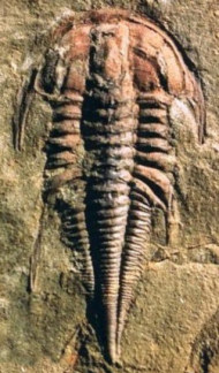
Emuellidae are a small family of trilobites, a group of extinct marine arthropods, that lived during the late Lower Cambrian of the East Gondwana supercontinent, in what are today South-Australia and Antarctica. Emuellidae can be recognized among trilobites in having a set of unique features. The headshield or cephalon has large genal spines reaching back as far as the 3rd to 6th segment of the thorax. The eye-ridges contact the back of the frontal lobe of the glabella and extend laterally and backwards, roughly parallel to the frontal and lateral rim of the cephalon. There are small, clearly incised pits at the junction between the eye-ridge and the frontal lobe of the cephalic axis. The thorax reaches its greatest width at the 6th segment. The frontal part or prothorax consists of 6 segments, with number 5 and 6 fused, and the 6th carrying very large trailing spines. The rear part or opistothorax consists of a variable but extremely large number of segments.

Redlichia is a genus of redlichiid trilobite in the family Redlichiidae, with large to very large species. Fossils of various species are found in Lower Cambrian (Toyonian)-aged marine strata from China, Korea, Pakistan, the Himalayas, Iran, Spain, southern Siberia, and Antarctica, and from Middle Cambrian (Ordian)-aged marine strata of Australia.

The Emu Bay Shale is a geological formation in Emu Bay, South Australia, containing a major Konservat-Lagerstätte. It is one of two in the world containing Redlichiidan trilobites. The Emu Bay Shale is dated as Cambrian Series 2, Stage 4, correlated with the upper Botomian Stage of the Lower Cambrian.

Dikelocephalus is a genus of very large trilobites of up to 50 cm (20 in) long, that lived during the last 3 million years of the Cambrian (Sunwaptan). Their fossils are commonly found as disarticulated sclerites, in the upper Mississippi Valley and in Canada (Alberta). The exoskeleton is rounded anteriorly, with the thorax and sides of the tailshield slightly tapering to about ⅔× of the width across the base of the spines at the back of the headshield. At the side corners of the pygidium there may be triangular or hooked spines, pointing backwards, while between the spines the posterior margin is at a 30-75° angle with the lateral margin, gently convex or nearly straight. If pygidial spines are lacking, the margin is gradually rounded. The thorax has 12 segments.
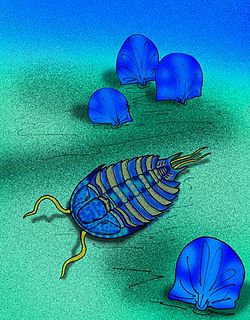
Meteoraspis is an extinct genus of ptychopariid trilobites of the family Tricrepicephalidae. The various species lived from 501 to 490 million years ago during the Dresbachian faunal stage of the late Cambrian Period. Fossils of Meteoraspis are characteristic of Late Cambrian strata in North America, though they are found in Late Cambrian strata elsewhere in the world, such as M. nevensis from Victoria Land, Antarctica.
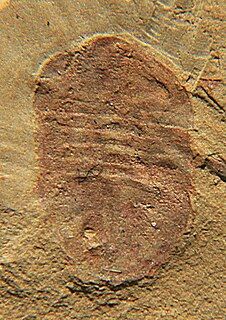
Panlongia was a small-sized marine arthropod, with an oval-shaped non-calcified exoskeleton. Both the head shield and the tail shield are semi-circular. In between the cephalon and pygidium are four thoracic body segments (somites). The cephalon occupies approximately ⅓ of the body length, the thorax ¼ and pygidium about 45%. Panlongia lived during the late Lower Cambrian (Botomian) in what is today South China. In Panlongia spinosa the edge of the exoskeleton carries several small sawtooth-like spines, that are absent in P. tetranodusa.

Aaveqaspis is a genus of small marine arthropods of unclear affiliation, that lived during the early Cambrian period. Fossil remains of Aaveqaspis were collected from the Lower Cambrian Sirius Passet fossil-Lagerstätte of North Greenland. Aaveqaspis looks like a soft eyeless trilobite with a weakly defined axis, a headshield with stubby genal spines, 5 thorax segments also ending in stubby genal spines, and a tailshield (pygidium) with a pair of massive tusk-like spines, and two smaller spines near the end of the axis. The only species presently known is A. inesoni.
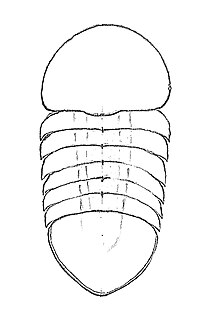
Buenaspis is a genus of small marine arthropods in the family Liwiidae, that lived during the early Cambrian period. Fossil remains of Buenaspis were collected from the Lower Cambrian Sirius Passet Lagerstätte of North Greenland. Buenaspis looks like a soft eyeless trilobite. It has a headshield slightly larger than the tailshield (pygidium), and in between them six thoracic body segments (somites). The genus is monotypic, its sole species being Buenaspis forteyi.
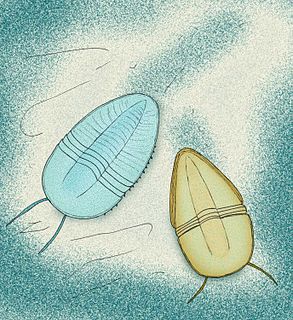
Emucarididae is an extinct family of soft-shelled trilobite-like arthropods (nektaspids) from the Lower Cambrian of South Australia and South China. It contains only two genera – Emucaris and Kangacaris. Two species were described in 2010 from specimens recovered from Emu Bay Shale Lagerstätte, one species in 2012 from the Maotianshan Shales. It is classified under the order Nektaspida, and is a sister-group to the families Liwiidae and Naraoiidae.
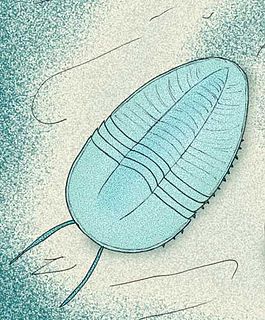
Kangacaris is an extinct genus of soft-shelled trilobite-like arthropod of the nektaspid order from the Lower Cambrian (Botomian). K. zhangi is known from South Australia, and K. shui from South-West China.
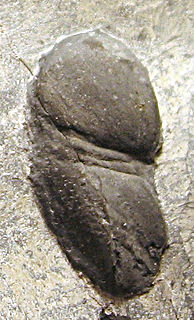
Tariccoia is a genus of small to average size marine arthropods in the Liwiidae Family, that lived during the late Ordovician period. Fossil remains of Tariccoia were collected from Sardinia, Italy. Tariccoia looks like a large, soft agnostid trilobite. It has a headshield wider than the tailshield (pygidium), and in between them three thoracic body segments (somites). The genus is monotypic, its sole species being Tariccoia arrusensis.
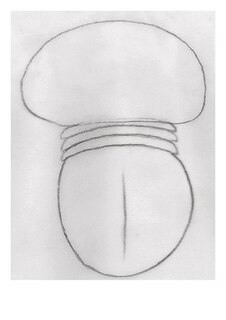
Soomaspis is a genus of small to average size marine arthropods in the Liwiidae Family, that lived during the late Ordovician. Fossil remains of Soomaspis were collected from the Soom Shale Lagerstätte in Western Cape, South Africa. Soomaspis looks like a large, soft agnostid trilobite. It has a headshield wider than the tailshield (pygidium), and in between them three thoracic body segments (somites). The genus is monotypic, its sole species being Soomaspis splendida.

Pseudonaraoia is a genus of small marine arthropods within the family Naraoiidae, that lived during the late Middle Ordovician period. The only species presently known is Pseudonaraoia hammanni.
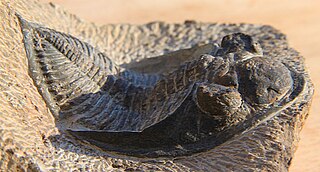
Odontochile is a genus of trilobites in the order Phacopida, family Dalmanitidae.

Eodiscina is trilobite suborder. The Eodiscina first developed near the end of the Lower Cambrian period and became extinct at the end of the Middle Cambrian. Species are tiny to small, and have a thorax of two or three segments. Eodiscina includes six families classified under one superfamily, Eodiscoidea.

Thoracocare is a minute to very small trilobite, that lived during part of the Middle Cambrian in what are today the states of Idaho, Nevada and Utah. It is the only trilobite known with just two thorax segments outside most members of the Agnostida order. It can be distinguished from Agnostida by the very wide subquadrate glabella, parallel-side or widening forward in the largest specimen, with the full front side touching the border. Two species are known, one, T. idahoensis, only from pygidia.

Tricrepicephalus is an extinct genus of ptychopariid trilobites of the family Tricrepicephalidae with species of average size. Its species lived from 501 to 490 million years ago during the Dresbachian faunal stage of the late Cambrian Period. Fossils of Tricrepicephalus are widespread in Late Cambrian deposits in North America, but is also known from one location in South-America. Tricrepicephalus has an inverted egg-shaped exoskeleton, with three characteristic pits in the fold that parallels the margin of the headshield just in front of the central raised area. The articulating middle part of the body has 12 segments and the tailshield carries two long, tubular, curved pygidial spines that are reminiscent of earwig's pincers that rise backwards from the plain of the body at approximately 30°.
Anabaraspis is a genus of redlichiid trilobite. A. splendens occurs in the uppermost Lower Cambrian and lowest Middle Cambrian of Russia. In Anabaraspis there is a long area in front of the glabella which is not differentiated in a border and a preglabellar field. This is a unique character in the family Paradoxididae. The frontal lobe of the central raised area of the headshield is slightly pointed, rather than rounded or truncate, a character shared with Plutonides, though, in Plutonides it hangs over the short anterior border.

Squamacula is an extinct arthropod from the Cambrian Series 2, the type species S. clypeata was described in 1997 from the Chengjiang biota. At the time of description there were only two known specimens of S. clypeata, but now there are at least six known specimens. In 2012 a second species S. buckorum was described from the Emu Bay Shale of Australia.



















